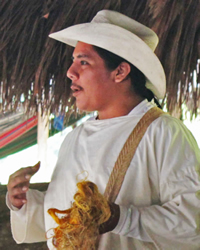Wiwa in Colombia

Photo Source:
Anders1716 - Wikimedia
Creative Commons
|
Send Joshua Project a map of this people group.
|
| People Name: | Wiwa |
| Country: | Colombia |
| 10/40 Window: | No |
| Population: | 19,000 |
| World Population: | 19,000 |
| Primary Language: | Sanka |
| Primary Religion: | Ethnic Religions |
| Christian Adherents: | 2.10 % |
| Evangelicals: | 0.40 % |
| Scripture: | New Testament |
| Ministry Resources: | No |
| Jesus Film: | No |
| Audio Recordings: | Yes |
| People Cluster: | South American Indigenous |
| Affinity Bloc: | Latin-Caribbean Americans |
| Progress Level: |
|
Introduction / History
The Wiwa live in the valleys of the Sierra Nevada Mountains of Colombia, between Valledupar and Santa Marta. The bulk of the population lives on the southeast side of the mountains. They are the smallest of the three traditional Sierra tribes and are struggling to retain a separate identity.
What Are Their Lives Like?
The Wiwas have a very democratic system of governing. Once every few weeks, all the men in the area meet in the men's house and stay all night discussing and voting on all conflicts and ideas. Between these meetings, the Cabildes and Mamos (shamans) oversee carrying out the decisions.
The people have two houses, one on their farmland where they live most of the time and one in the village where they stay during town meetings.
They wear white, cotton clothes, and the men have long hair. It's important to their cultural identity. They get rather offended if anyone suggests that they change either one of those parts of their appearance.
One thing to note is that only about 65% of the Wiwas speak the native language Damana, a fact that contributes to differing reports of total population figures.
The Wiwa suffer from extreme poverty. Child malnutrition is a major problem. In addition, the Wiwa are struggling to keep their land from encroachment of Spanish-speaking settlers. Education among the Wiwa is almost non-existent.
What Are Their Beliefs?
Their beliefs contain a lot of animism and worship of nature. The "Ancient Mother" is the main deity and is something akin to Mother Earth. The shamans are called Mamos and are highly respected. They perform all kinds of rituals, from marriage ceremonies to rites of passage to divination. They are usually the leaders of the village.
What Are Their Needs?
The Wiwas are very poor. Malnutrition is a major problem among the children and medical care is usually at least a day's walk away. The child mortality rate is high. Settlers are encroaching on their land, and many have already been displaced because of violence. Education is very sparse and of poor quality. One of the reasons for this is that there is still no set alphabet to write their language (Damana). They have no part of Bible translated into their language yet and no missionary is currently working in their land.
Prayer Points
Pray for the Holy Spirit to move in Wiwa communities in such a way they will accept the blessings of Christ's goodness and lordship.
Pray for a spiritual openness among the Wiwa that will lead them to the cross and the empty grave. May they rejoice in Christ's resurrection victory!
Pray for loving workers in Wiwa communities.
Pray for Wiwa disciples to make more disciples.